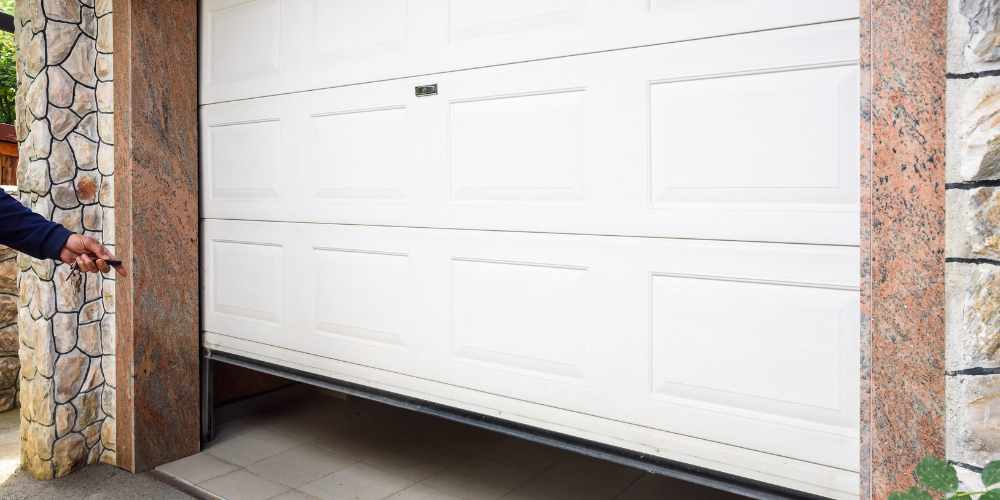
Is your garage door only opening a foot when you press the opener button? It can be frustrating and inconvenient to deal with a malfunctioning garage door, especially if it hampers your daily routine. However, understanding the common causes behind this issue and following some troubleshooting steps can often help you resolve the problem. In this article, we will explore the potential reasons why your garage door only opens a foot and provide you with practical solutions to get it working smoothly again.
Common Reasons for a Garage Door Opening Only a Foot
#1. Insufficient Power Supply
If your garage door only opens a foot and then abruptly stops, the first thing you should check is the power supply. Inadequate power can cause your garage door opener to function improperly.
#2. Lack of Lubrication
One of the common culprits behind a partially opening garage door is insufficient lubrication. Over time, the moving parts of the garage door system, such as hinges, rollers, and tracks, can become dry and stiff. This leads to increased friction and resistance, preventing the door from opening fully.
#3. Broken Springs
Garage door springs play a vital role in counterbalancing the weight of the door and supporting its smooth operation. When a spring breaks or becomes worn out, it can affect the door’s ability to open fully. If you notice a gap or unevenness in the springs or hear a loud snapping sound, it’s likely that a broken spring is causing the issue.
#4. Misaligned Tracks
The tracks along which your garage door operates need to be properly aligned for smooth movement. If the tracks become misaligned due to accidental bumps or regular wear and tear, it can restrict the door’s range of motion. This misalignment often results in the door opening partially or getting stuck.
#5. Sensor Issues
Modern garage doors are equipped with safety sensors that detect obstacles in the door’s path. If these sensors are misaligned or obstructed by dirt or debris, they may prevent the door from opening fully. The safety feature kicks in, limiting the door’s movement to avoid potential accidents.
#6. Motor Problems
The garage door opener motor provides the necessary power to lift and lower the door. If the motor is malfunctioning or experiencing electrical issues, it may lack the strength to open the door completely. This can lead to the door stopping after only a short distance.
#7. Remote Control Malfunction
In some cases, the issue may lie with the remote control itself. If the remote control batteries are weak or the device is faulty, it may not send a strong enough signal to the opener, resulting in the door opening only partially.
Troubleshooting Tips to Fix a Garage Door Opening Only a Foot

To address the problem of a garage door opening only a foot, you can try the following troubleshooting tips:
#1. Insufficient Power Supply
Here are some steps to find and fix this issue:
- Check the power outlet: Ensure that the power outlet, where your garage door opener is plugged in, is functioning correctly. Plug in another device to verify if the outlet is providing power.
- Inspect the power cord: Examine the power cord for any visible damage or frayed wires. If you notice any issues, replace the cord immediately.
- Test the circuit breaker: Check the circuit breaker or fuse box connected to your garage door opener. Reset any tripped breakers or replace blown fuses.
- Consider a dedicated circuit: If your garage door opener shares a circuit with other power-hungry appliances, it may not be receiving sufficient power. Consult an electrician to install a dedicated circuit for your garage door opener.
#.2 Lubricate Moving Parts
Start by thoroughly lubricating all the moving parts of your garage door system, including hinges, rollers, tracks, and springs. Use a high-quality garage door lubricant and apply it generously to ensure smooth operation. Regular lubrication not only reduces friction but also helps in preventing garage door rust and extends the lifespan of the components.
#3. Check and Replace Springs
Inspect the garage door springs for any signs of damage or wear. If you notice a broken spring or suspect that they are worn out, it’s crucial to replace them promptly. Dealing with garage door springs can be dangerous, so it’s recommended to seek professional assistance to ensure safe and proper installation.
#4. Inspect and Adjust Tracks
Carefully examine the tracks to check for any misalignment. Use a level to ensure they are perfectly straight. If you notice any deviations or gaps between the tracks and the door, loosen the mounting brackets and gently tap the tracks back into position. Retighten the brackets once the tracks are aligned correctly.
#5. Verify Sensor Alignment
Inspect the safety sensors located near the bottom of the garage door tracks. Ensure they are clean, aligned properly, and not blocked by any objects. Use a soft cloth to clean the sensors and adjust their position if necessary. Most garage door openers have indicator lights on the sensors that will help you determine if they are properly aligned.
#.6 Examine the Motor and Drive System
Check the garage door opener motor and drive system for any visible signs of damage or lose connections. If you notice any issues, such as frayed wires or burned-out components, it’s best to contact a professional garage door repair service to diagnose and fix the problem.
#7. Test Remote Control Functionality
Replace the batteries in your remote control and test its functionality. Make sure the signal reaches the opener consistently and with sufficient strength. If the remote control still doesn’t operate the door properly, try reprogramming it according to the manufacturer’s instructions. If the problem persists, consider replacing the remote control.
Dealing with a garage door that only opens a foot can be a frustrating experience. However, by following the troubleshooting steps outlined in this article, you can identify the underlying cause of the issue and take appropriate action to resolve it. Whether it’s addressing power supply problems, realigning safety sensors, or repairing damaged tracks and rollers, there are solutions available for you. Remember, if you’re unsure or uncomfortable with the repairs, it’s always best to seek professional assistance to ensure the safety and functionality of your garage door.
Professional Help: When to Call a Garage Door Repair Service
While troubleshooting and attempting DIY fixes can often resolve the issue of a garage door opening only a foot, certain situations may require the expertise of a professional garage door repair service. It’s advisable to seek professional help in the following scenarios:
- The issue persists even after performing troubleshooting steps.
- The garage door opener motor shows signs of serious damage.
- The garage door springs are broken or damaged.
- The tracks are severely misaligned or damaged.
- You are unfamiliar with the complex mechanics of garage doors.
Calling a professional ensures that the problem is accurately diagnosed and fixed, preventing further damage and ensuring your safety.
>>>>>Important>>>>>>
“Do not attempt to pass through a partially opened garage door. This can cause serious injury or even death.”

FAQs
1. Can I fix the problem myself, or should I seek professional help?
The answer depends on your level of expertise and comfort with handling garage door repairs. If you are experienced with DIY projects and have a good understanding of garage door mechanics, you can attempt to troubleshoot and fix the issue yourself. However, if you are unsure or lack the necessary skills, it is recommended to seek professional help. Garage doors are heavy and complex systems, and improper repairs can lead to further damage or even personal injury.
2. Are there any temporary solutions if I need my garage door to function immediately?
If you require immediate access to your garage and a temporary solution is necessary, you can try manually opening and closing the door. Disengage the garage door opener by pulling the emergency release cord, and then lift the door manually. However, keep in mind that this is not a long-term solution and should only be used temporarily until the underlying issue is resolved.
3. How much does it cost to repair a garage door that only opens a foot?
The cost of repairing a garage door that only opens a foot can vary depending on the specific problem and the region you are in. Simple fixes such as realigning sensors or cleaning tracks may be relatively inexpensive, while more complex issues like a motor replacement or track repair can be more costly. It is best to contact a reputable garage door repair service for a detailed assessment and cost estimate.
4. How often should I lubricate my garage door?
It’s recommended to lubricate your garage door’s moving parts, such as hinges, rollers, tracks, and springs, at least once every six months for optimal performance.
5. Can I fix a broken garage door spring myself?
Dealing with garage door springs can be dangerous due to the high tension they hold. It is not advisable for inexperienced individuals to attempt fixing broken garage door springs themselves. It’s best to seek professional assistance to ensure a safe and proper replacement.
6. How do I align the sensors on my garage door?
To align the sensors on your garage door, first, make sure they are clean and free from any obstructions. Then, adjust their position so that they are facing each other directly. Use a level to ensure they are aligned perfectly, and make any necessary adjustments until the indicator lights on the sensors indicate proper alignment.
7. What should I do if my garage door motor stops working?
If your garage door motor stops working, check for any visible signs of damage or loose connections. If you’re unable to identify or fix the issue yourself, it’s recommended to contact a professional garage door repair service to diagnose and repair the motor problem.
8. Can weather conditions affect the garage door’s performance?
Yes, extreme weather conditions can impact the performance of your garage door. Temperature changes, humidity, and severe weather events like storms or heavy rainfall can affect the tracks, rollers, and even the garage door opener itself. It is important to keep your garage door well-maintained and address any weather-related issues promptly to prevent further damage.
9. What are the benefits of regular garage door maintenance?
Regular garage door maintenance offers several benefits, including:
- Extending the lifespan of the garage door and its components
- Preventing unexpected breakdowns and costly repairs
- Ensuring smooth and reliable operation
- Enhancing home security by keeping the garage door in optimal condition
- Maximizing energy efficiency by reducing air leaks
- Maintaining the warranty validity of your garage door and opener

